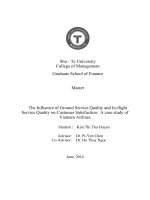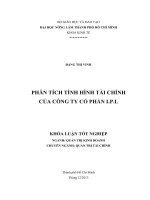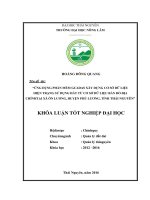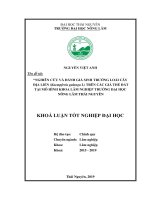Testing the effect of kaempferia galanga l on the larv ae of pieris rapae l (khóa luận tốt nghiệp)
Bạn đang xem bản rút gọn của tài liệu. Xem và tải ngay bản đầy đủ của tài liệu tại đây (813.2 KB, 42 trang )
VIETNAM NATIONAL UNIVERSITY OF AGRICULTURE
FACULTY OF BIOTECHNOLOGY
------------------------------
GRADUATE THESIS
TESTING THE EFFECT OF KAEMPFERIA
GALANGA L. ON THE LARVAE OF PIERIS RAPAE L.
HANOI-2021
VIETNAM NATIONAL UNIVERSITY OF AGRICULTURE
FACULTY OF BIOTECHNOLOGY
------------------------------
GRADUATE THESIS
TESTING THE EFFECT OF KAEMPFERIA
GALANGA L. ON THE LARVAE OF PIERIS RAPAE L.
Student
: Trinh Thi Huong Tra
ID
: 610681
Class
: K61CNSHE
Supervisor
: Dr. Dang Thi Thanh Tam
HA NOI-2021
COMMITMENT
I hereby declare that all information in this document has been obtained
and presented in accordance with academic rules and ethical conduct.
I also declare that all the help to complete this thesis has been thanks.
Trinh Thi Huong Tra
i
ACKNOWLEDGEMENT
This study would not have been possible without the support of many
people. I would like to express my gratitude to my professors of Department
of Plant Biotechnology at Faculty of Biotechnology in Vietnam National
University of Agriculture for their support and conducting the research.
Particular thanks to Dr. Dang Thi Thanh Tam for her valuable
comments and helpful advice, scientific , and valuable feedback throughout
the time studying at the laboratory of the Department of Plant technology.
I would also like to extend my partner Nguyen Dinh Thinh for helping
me to perform some experiments.
Finally, I would like to express my special thanks to my family for
great encouragement as well as my friends for their supports.
Trinh Thi Huong Tra
ii
CONTENTS
COMMITMENT ................................................................................................ i
ACKNOWLEDGEMENT ................................................................................ ii
CONTENTS ..................................................................................................... iii
LIST OF TABLES ............................................................................................ v
LIST OF FIGURES.......................................................................................... vi
PART I. INTRODUCTION .............................................................................. 1
1.1. Introduction ................................................................................................ 1
1.2. Purpose and requirement ............................................................................ 2
1.2.1. Purpose .................................................................................................... 2
1.2.2. Requirement ............................................................................................ 2
1.3. Research location ....................................................................................... 2
PART II. LITERATURE REVIEW.................................................................. 3
2.1. Pieris rapae ................................................................................................. 3
2.2. Some researchs on Pieris rapae ................................................................. 8
2.3. Kaempferia galanga L. ............................................................................. 10
PART III. MATERIALS AND METHODS .................................................. 13
3.1.Materials .................................................................................................... 13
3.1.1.Research materials ................................................................................. 13
3.1.2. Instruments and chemicals .................................................................... 13
3.2. Methods .................................................................................................... 13
3.2.1. Growing cabbage .................................................................................. 13
3.2.2. Pieris rapae culture ................................................................................ 14
3.2.3. Preparation the plant extracts ................................................................ 15
3.2.4. Toxicity tests ......................................................................................... 16
3.2.5. Antifeeding test ..................................................................................... 18
3.3. Experiments .............................................................................................. 19
iii
PART IV. RESULTS AND DISCUSSIONS ................................................. 21
PART V. CONCLUSIONS AND SUGGESTIONS ...................................... 27
5.1. Conclusions .............................................................................................. 27
5.2. Suggestions .............................................................................................. 27
REFERENCES ................................................................................................ 28
iv
LIST OF TABLES
Table 4.1. Mortality rate of larvae during Kaempferia galanga L.
treatment ............................................................................................... 21
Table 4.2 Dose–response parameters of Pieris rapae after 24 hours ............. 23
Table 4.3. Deterrence percentage acreage leaves of Kaempferia galanga
extract on Pieris rapae larvae ................................................................ 24
v
LIST OF FIGURES
Figure 2.1 Butterfly and larvae of Pieris rapae ................................................ 3
Figure 2.2 Eggs of Pieris rapae ........................................................................ 4
Figure 2.3 Five stages of Pieris rapae larvae ................................................... 5
Figure 2.4 Pupae of Pieris rapae ...................................................................... 6
Figure 2.5 Adult of Pieris rapae ....................................................................... 7
Figure 2.6 Kaempferia galanga plants ........................................................... 10
Figure 3.1 Cabbage seeds ................................................................................ 14
Figure 3.2 The process of growing cabbage ................................................... 14
Figure 3.3 Pieris rapae culture ....................................................................... 15
Figure 3.4 Preperation steps of the Kaempferia galanga L extract ................ 16
Figure 3.5 Steps of toxicity tests ..................................................................... 17
Figure 3.6 Steps of antifeeding test ................................................................. 19
Figure 4.1. Mortality rate of larvae after 24 hours of treatment ..................... 21
Figure 4.2 Testing toxicity of (4%) Kaempferia galanga extract on
Pieris rapae larvae. ............................................................................... 23
Figure 4.3 The leaf consumption of larvae in the treatment with 0.5%
Kaempferia galanga extract .................................................................. 24
Figure 4.4 The leaf consumption of larvae in the treatment with 1%
Kaempferia galanga extract .................................................................. 25
Figure 4.5 The effect of Kaempferia galanga extract on the antifeeding
of Pieris rapae larvae ........................................................................... 26
vi
PART I. INTRODUCTION
1.1. Introduction
In Vietnam, cruciferous vegetables (broccoli, cabbage, cauliflower,
kale, collards ...) are preferred by many people because of their rich nutrients.
They have high economic value and are widely grown. Cruciferous
vegetables are the main crops of many regions such as Sapa, Son La, Đa
Lat,...However, cruciferous vegetables have a short growth time, so they are
planted continuously, harvested in scattered batches. Besides, they have the
features of stems, soft and weak leaves, containing many nutrients. It is
suitable with the warm and humid climate of our country, so it is damaged by
many kinds of worms such as silkworm, Pieris rapae, click beetles ...,
seriously affecting the productivity and quality of vegetables (Trinh, 1999). In
the cruciferous vegetable pest group, Pieris rapae is the most dangerous pest
for vegetables. Every year they appear from 14-15 times, with high density
(Lam, 2008).
Pieris rapae is a small to medium-sized butterfly species of the family
Pieridae. It is believed to have originated in the Eastern Mediterranean and
widespread in Europe and Asia. The butterfly is recognizable by its white
color with small black dots on its wings. Young caterpillars gnaw the green
matter of vegetable leaves. From stage two or more, they gnaw leaf blades
and remain only the veins. Their waste can spoil the leaves. So if the high
density is left, the field of vegetables will be bare and frayed.
To control Pieris rapae, the farmers mainly use chemical methods. In
vegetable-growing areas, pesticides are used extensively and continuously.
Chemical control is highly effective but it contains negative risks to
organisms, the ecosystem and human health. These drawbacks associated
have spurred the search for biological pesticides. Because biological control is
an environmentally friendly method for the environment. In this field, plant
1
extract is a solution commonly. However, this method still exist some
limitations. It is more susceptible to environmental conditions, slow action
and sometimes is unpredictable. Because of the reasons above, the study was
performed to find the plant extracts that have highly effective insecticide on
Pieris rapae.
1.2. Purpose and requirement
1.2.1. Purpose
Testing the effect of Kaempferia galanga extract to control Pieris
rapae.
1.2.2. Requirement
Testing the toxicity of Kaempferia galanga extracts on young
caterpillars.
Testing the antifeeding effect of Kaempferia galanga extracts on
young caterpillars.
1.3. Research location
The study was performed at Department of Plant Biotechnology
,Faculty of Biotechnology and Institute of Agro- Biology in Vietnam Nation
University of Agriculture.
2
PART II. LITERATURE REVIEW
2.1. Pieris rapae
Classification
Order
Lepidoptera
Family
Pieridae
Genus
Pieris
Species
P. Rapae
Binomial name
Pieris rapae
Figure 2.1 Butterfly and larvae of Pieris rapae
Pieris rapae is a small to medium sized butterfly species of family
Pieridae. The butterfly is recognizable by its white color with small black
dots on its wings. Their hot plants are crucifer crops such as cabbage, kale,
bok choy and broccoli….. Pieris rapae is found principally in temperate
regions of Europe, Africa, Asia, and North America, but now it appear in
Australia and New Zealand, southerm Mexico, and Hawaii… Imported Pieris
rapae was first observed in North America in 1860 (Beirne, 1971).
The life cycle of Pieris rapae has four stage: egg, larvae, pupae and
butterfly. It requires three to six weeks and depending on weather and
temperature. Imported cabbageworm can be found throughout the year in
Vietnam and the most quantity at time from autum to winter when the source
food is plentiful.
3
Egg:
Figure 2.2 Eggs of Pieris rapae
The egg is yellow and has surface ridges running lengthwise and
crosswise. The egg is laid on end, usually on the under surface of the leaves.
They occur singly, never in clusters. Eggs hatch in 3 to 7 days (Ronald, 2007).
Larvae :
The green caterpillar has a slender yellow stripe along the middle of the
back, and another intermittent yellow stripe along each side of the body.The
instar have five stages. The body length are about 0.4, 0.6, 0.97, 1.5, and 2.2
cm, respectively. Body lengths at maturity of each instar averages from 2 to 3
cm respectively. The larvae requires about 15 days (range 11 to 33 days) to
complete its development. The best condition to develop
temperature and 75% - 85% humidity (Muggeridge,1942).
4
at 20-24°C
Figure 2.3 Five stages of Pieris rapae larvae
The 1st instar of Pieris rapae after hatching, the body of the larvae is
ivory-white or milky-white, sometimes pale yellow. Average length of 1st
instar lavae
body is 2.76 ± 0.043mm, average body width is 0.40 ±
0.0047mm. At 2nd instar, the lavae has a green color similar to the color of the
leaf, the body has more feathers. The average length is 6.75 ± 0.11mm. Body
width ranges from 0.52-0.67mm. The body of the 3rd instar is green, the head
is light brown. Average body length is 13.45 ± 0.10mm (12.40 -14.23mm).
Average body width is 0.96 ± 0.01mm (0.83 -1.12mm). The 4th instar of
Pieris rapae has the maximum number of fluff. Average body length is 19.11
± 0.15mm (17.36 - 20.45mm). Average body width is 0.96 ± 0.013mm (1.34 1.58mm). Larvae at stage 5 is very voracious, maximum body size, the body
still is green and covered with fluff. Body length ranges from 25.89 - 30.12
mm. Body width ranges from 1.74 - 2.21mm (Huong, 2011).
5
Pupae :
Pupae is usually green, but gray or tan colored pupae occur often. It has
sharp angular projections over the back and front. Pupae are attached to the
under surface of leaves by silk at the tail and a silk rope near the midsection.
Pupae are about 3/4 inch long and are found on the plant or in a sheltered area
up to 15 yards away from the host plant. Pupal development is completed in 1
to 2 weeks (Ronald, 2007).
Figure 2.4 Pupae of Pieris rapae
Adult
The butterfly has a wing span of about 1-1/2 inches. The forewings are
black-tipped. A female has two black spots on top of each of her forewings; a
male has only one spot (Ronald, 2007). When viewed from below, the wings
generally are yellowish, and the black spots usually show faintly through the
wings. The body of the butterfly is covered with dense hair, which is colored
white in females, but darker in males. The adult typically lives about three
weeks. The female produces 300 to 400 eggs. The adult is very active during
the daylight hours, often moving from the crop to flowering weeds to feed
(Harcourt,1962).
6
Figure 2.5 Adult of Pieris rapae
The Pieris rapae larvae is voracious. Once it hatches from the egg, it
eats its own eggshell and then moves to eat the leaves of the host plant. It
bores into the interior of the cabbage, feeding on the new sprouts. The
mustard oil from the host plant makes the larvae distasteful to birds. The
larvae adjust their feeding rate to maintain a constant rate of nitrogen uptake.
They will feed faster in low nitrogen environment and utilize the nitrogen
more efficiently (at the cost of efficiency in other nutrients) than larvae
hatched on high nitrogen host plant. However, there is no significant
difference in growth rate was observed between larvae in the two
environments ( Scott, 1986). Considered a serious pest, the caterpillar is
known to be responsible for annual damage worth hundreds of thousands of
dollars (Holland, 1931).
The larvae are shown to disperse their damage on the plants. Larvae are
shown to feed mostly during the day. They move around the plant mostly
spending their time feeding. A feeding bout is immediately followed by a
change in position, either to a new leaf or to another part of the same leaf
(Maurico, 1990). This dispersal of damage is seen as an adaptive behavior to
hide the visual cues from predators that rely on vision. Even though Pieris
rapae larvae are cryptic, they remain in the sun for the majority of the day,
rather than hiding on the underside of the leaf. The condition of the host plant
influences the larvae growth significantly. From the stage two or more, they
7
gnaw leaf blade and remain only the veins. Their waste can spoil the leaves.
So if the high density is left, the field of vegetables will be bare and frayed.
2.2. Some researchs on Pieris rapae
For the past 30 years, scientists have been studying about plant extracts
and phytochemicals to develop the insecticides that reduce the human health
and environment. The damage due to insects may be up to 10–20% every year
(Ferry et al. 2004). To reduce the damage caused by Pieris rapae on
cruciferous vegetables, many authors from over the world have been had
many studies on different kinds of plant extracts and had obtained positive
results.
Seyedeh et al ( 2011) performed a study on Pieris rapae with two
medicinal plants ( Artemisia annua L and Achillea millefolium L.). The
Artemisia annua and Achillea millefolium extract were extracted on methanol
slovent by procedure of Warthen et al (1984). Toxicity tests were performed
at 0.625%, 1.25%, 2.5%, 5%, and 10% concentrations of the extracts on
larvae at stage 3 of Pieris rapae. It was followed after 24h and 48h and
determined LC5, LC25. The result showed that after 48h LC50 and LC25
values of Artemisia annua L were 9.387% and 4.19%, LC50 and LC25
values of Achillea millefolium L were 3.645% and 1.69%. Achillea
millefolium L extract was more toxic. Deterrency tests were the tests to
determine the leaf consumption of young caterpillars. The treatment leaves
were treated at 0.625% concentration and compared with the control leaves
after 24 hours. As the result, Achillea millefolium L extract ( with deterrency
was 44.185%) had antifeeding for lavae more than Artemisia annua L extract
(29.826%). Thus, extracts of Artemisia annua L and Achillea millefolium L
had toxic effects and antifeeding effects on Pieris rapae.
Also performed experiments on Pieris rapae, Manal (2015) et al used
four plant extracts of vinca, ak, neem and chinaberry. The hexane, acetone
8
and ethanol (1:1:1) slovent was used to extract. The experiment was arranged
as follows: Cabbage leaves were treated at different concentrations from 500
to 15000 ppm and fed the larvae at stage 3. Mortality was monitored every
day and ended after 7 days. The results showed that all four kinds of plant
extracts caused larvae lethal at all concentrations. The concentration of the
extract was higher lead to the mortality rate was higher. The highest mortality
was ak tree with 93.33% at 10000ppm after 7 days. The next is neem and
vinca extracts with 86.67% at the highest concentration. At 5000ppm
concentration upwards of all the plant extracts, mortality rate was over 60% at
the end of the experiment. In conclusion, ak extract was the most toxic effect
to young caterpillar of Pieris rapae followed by extracts of neem, vinca.The
last was chinaberry extracts with 80% death lethal at the highest
concentration.
Esmat et al ( 2019) used plant oils ( oils of garlic, mint, thyme,
camphor, colocynth, cumin, fenugreek, orange) to determind the oviposition
and antifeeding effects on Pieris rapae. They tested at 250, 500 and 1000
µg/L concentrations for all the oils. In anti-feeding testing, the larvae at stage
4 were used. The researchers found out that, the higher the oil concentration
leads to anti-feeding effects more efficient. At the highest concentrations
(1000 µg/L), Garlic, Mint, Fenugreek bringed high effects with 87.21%,
86.93%, 79.13%. At 500 µg/L concentrations, Garlic, Mint, Camphor
bringed effects with 76.64%, 71.90% and 64.09% and thyme, fenugreek with
over 50%. There were Cumin and Orange oils did not antifeeding effect with
all concentrations. In the oviposition testing, They found that oviposition
effects in depended on the concentration of the plant oils. It had little effect at
low concentrations and vice versa. Oils from Mint, Thyme, Garlic reduced
oviposition 91.97%, 84.26%, 76.71% at 1000 µg/L concentration. Three oils
9
were not effective, Orange with 29.60%, Fenugreek with 28.70% and Cumin
with 39.76%.
In studies of Seyedeh et al (2011) and Manal (2015), dried leaves of
medicinal plants were used to extract extracts. The extracts also show their
efficacy with Pieris rapae the toxic and antifeeding effects were high with
increasing the concentration of the extracts. In the experiment of Manal, the
larvae that survived the experiment appeared defects. Results from the
reseach of Esmat et al show that garlic, mint oils are highly effective against
larvae of Pieris rapae and reduced oviposition of white butterfly.
2.3. Kaempferia galanga L.
Classification
Order
Zingiberales
Family
Zingiberaceae
Genus
Kaempferia
Species
K. galanga
Figure 2.6 Kaempferia galanga plants
Kaempferia galanga L. is native plants of Vietnam. It contains insect
resistant active ingredients that have been studied. It is grass stems that lives
for many years, roots sometimes bulging into small egg-shaped bulbs.
10
Rhizomes bulge into many adjacent tubers, fragrant and spicy, the outer shell
is golden brown, the cross-section is nearly round 2-3 cm , light yellow, white
fibrous. Kaempferia galanga has fruit around May - July. It is a light-loving,
moist, and drought-tolerant tree. Every year, the Kaempferia galanga grows
young leaves in April–5, grows rapidly in the summer, and then flowers.
Flowers bloom every day in the early morning and then fall at 10 o'clock. All
parts of plant over ground wither in winter. Distributed in India, Laos,
Cambodia, China, Malaysia, Indonesia, Vietnam. In Vietnam, it grow wild in
many places, often under the wet canopy of forests or grown as ornamental
and medicinal tubers.
Dried Kaempferia galanga rhizomes contain about 2.4–3.9% essential
oils. The main ingredients are p-methoxycinamic acid, ethyl cinamate and pmethoxy ethylcamide. In addition, rhizomes also contain compounds npentadecan, A3-carene, camphen, O-methoxy ethylcamide, borneol, cinamic
aldehydes, cineol, kaempferol, kaempferid ...(Singh, 2013)
The rhizomes of Kaempferia galanga have been used in traditional
medicine. Its alcoholic maceration of the rhizomes has also been applied as
liniment for rheumatism (Kanjanapothi, 2004). The decoctions and the sap of
the leaves may have hallucinogenic properties, which may be due to
unidentified chemical components of the plant’s essential oil fraction
(Thomas, 2002).
Singh et al (2013) pointed out that the methanolic extract of K. galanga
is
identified
ethyl
cinnamate,
ethyl
pmethoxycinnamate
and
p-
methoxycinnamic acid. Methanol rhizome extract has insecticidal property.
The ethyl esters of cinnamate and pmethoxycinnamate are antagonistic
toward the polyphagous of larvae Spodoptera littoralis. The LD50 is in the
range of 0.18-0.74µmol vial-1 (Pandji, 1993) 1250 and 2500 dose (in ppm)
11
respectively of extract against subsistence and growth of neonate larvae
S.littoralis in relative to controls.
Ranjan Dash et al (2017) showed effective against S. oryzae of
Kaempferia galanga L rhizome extracts.The rhizome was extracted by a cold
extraction method. The stock extracts are diluted with acetone (ACR),
petroether (PEF), chloroform (CHF) and methanol (MEF) at different
concentrations (2.5, 5, 10, 20, 40, 50, 60, 70 and 80 (mg/ml). The test samples
were evaluated for 12 and 24hr. In 12 hours among all the extracts, at the
concentrations of 80 mg/ml MEF showed the highest mortality (90%)
whereas ACR and CHF showed mortality rate (70%), PEF showed the lowest
result (50%). Specially, The mortality was 100% at the concentration of 80
mg/ml in all the extract in 24 hour. Besides, the methanolic extract of
Kaempferia galanga was effecticallarvicidal activity on the second stage of
dog roundworm larva, Toxocaracanis (KIuchi,1988). It was showed larvicidal
activity against Culexquinquefasciatus with LC50 values of 50.54ppm
(Pitassawat,1998). The hexane fraction, dichloromethane fraction and
methanolic fraction of Kaempferia galanga extract effected larvicidal and
repellent activities. The hexane fraction possesses larvicidal potency against
C. quinquefasciatus.
Kaempferia galanga L. extract have effect against some parasites and
insect. However, there are no studies of Kaempferia galanga L extract that
have been performed to evaluate the toxicity and antifeeding effects on Pieris
rapae in Vietnam and on the world.
12
PART III. MATERIALS AND METHODS
3.1.Materials
3.1.1.Research materials
Larvae of Pieris rapae L. (Lepidoptera: Pieridae).
Dried Kaempferia galanga rhizomes.
3.1.2. Instruments and chemicals
Instruments:
The flask, petri, pipet, eppendorf tubes 1.5 ml, filter paper,..
Analytical balance
Rotary vacuum evaporator
Magnetic stirrer
The container to feed larvae
Chemicals :
Methanol
distilled water
Analytical software
SPSS, GRAPHPAD
ImageJ software
Excel 2010
3.2. Methods
3.2.1. Growing cabbage
Cabbage seeds were cabbage hybrid x2 of Nong Nghiep 1 seeds. Seeds
were soaked in water for 8 hours, incubated for 24 hours at 35°C. Then the
seeds planted in the ground. After 12 days, the seedlings were transferred to
pots. 40 seedlings were planted in the field, 300 seedlings were planted in the
green house. Cabbages were watered daily and fertilizer NPK Dau Trau a
times every 20 days. I did not use any kind of pesticides. Cabbage leaves were
used for feeding young caterpillars and experiments.
13
Figure 3.1 Cabbage seeds
Figure 3.2 The process of growing cabbage
3.2.2. Pieris rapae culture
The larvae at all stage of Pieris rapae were collected in the field in
Institute of Agro-Biology of Vietnam National University of Agriculture.
Larvae were transferred into the box (65×25×20cm), fed with cabbage leaves.
These box were cleaned every day. Larvae were grown at 20°C to 25°C and
14
air humidity 65% to 75%. After larvae became pupae, the pupae were
removed into a net cage (1,5×1,2×1m). The cage were putted on green house
at 20°C to 25°C and air humidity 60% to 70%. Seven cabbages were putted
on the cage, white butterfly after hatching would lay eggs on these plants and
the larvae would feed on them. These larvae would be used for experiments.
Three petri dishes contained cottons that were soaked in honey solution in the
ratio of 8 water: 1 sugar: 1 honey. These petries were placed in the cages to
provide nutrition for the white butterfly.
Figure 3.3 Pieris rapae culture
3.2.3. Preparation the plant extracts
The Kaempferia galanga L extract were extracted in methanol slovent
by procedure of Warthen et al. Dried rhizomes of Kaempferia galanga L had
been ground into flour, 15g flour of Kaempferia galanga L were mixed with
150ml 85% methanol in a jar and keeped it at room temperature for 1 hour.
This solution was putted on fridge at 4°C for 48 hours, after that stirred for 1
hour by a magnetic stirrer. Then filtered off the dregs with filter paper and
obtained a clear solution. Solvent was evaporated by rotary vacuum
evaporator at 38°C. The crude extract was dissolved in 5ml methanol and
15
used as origin solution. This origin solution was diluted with distilled water at
different concentrations to use for experiments.
Figure 3.4 Preperation steps of the Kaempferia galanga L extract
3.2.4. Toxicity tests
The extract solution was diluted at five concentration: 0,5%, 1%, 2%,
4%, 8%, the sample control was 8% methanol. Each formula was performed
on 30 larvae at stage 3 for three times. Larvae starved for 4 hours before
performed experiment. Then the larvae was fed cabbage leaves that had
sprayed with the extract solution. Determine the LC50 value by SPSS after 24
hours and 48 hours.
16
Preparation the extract solution:
Formula
Extract
concentration
Stock solution (µl)
Distilled
water (µl)
Control
8% methanol
800 (methanol)
9200
1
0.5%
10
9950
2
1%
100
9900
3
2%
200
9800
4
4%
400
9600
5
8%
800
9200
Figure 3.5 Steps of toxicity tests
17









